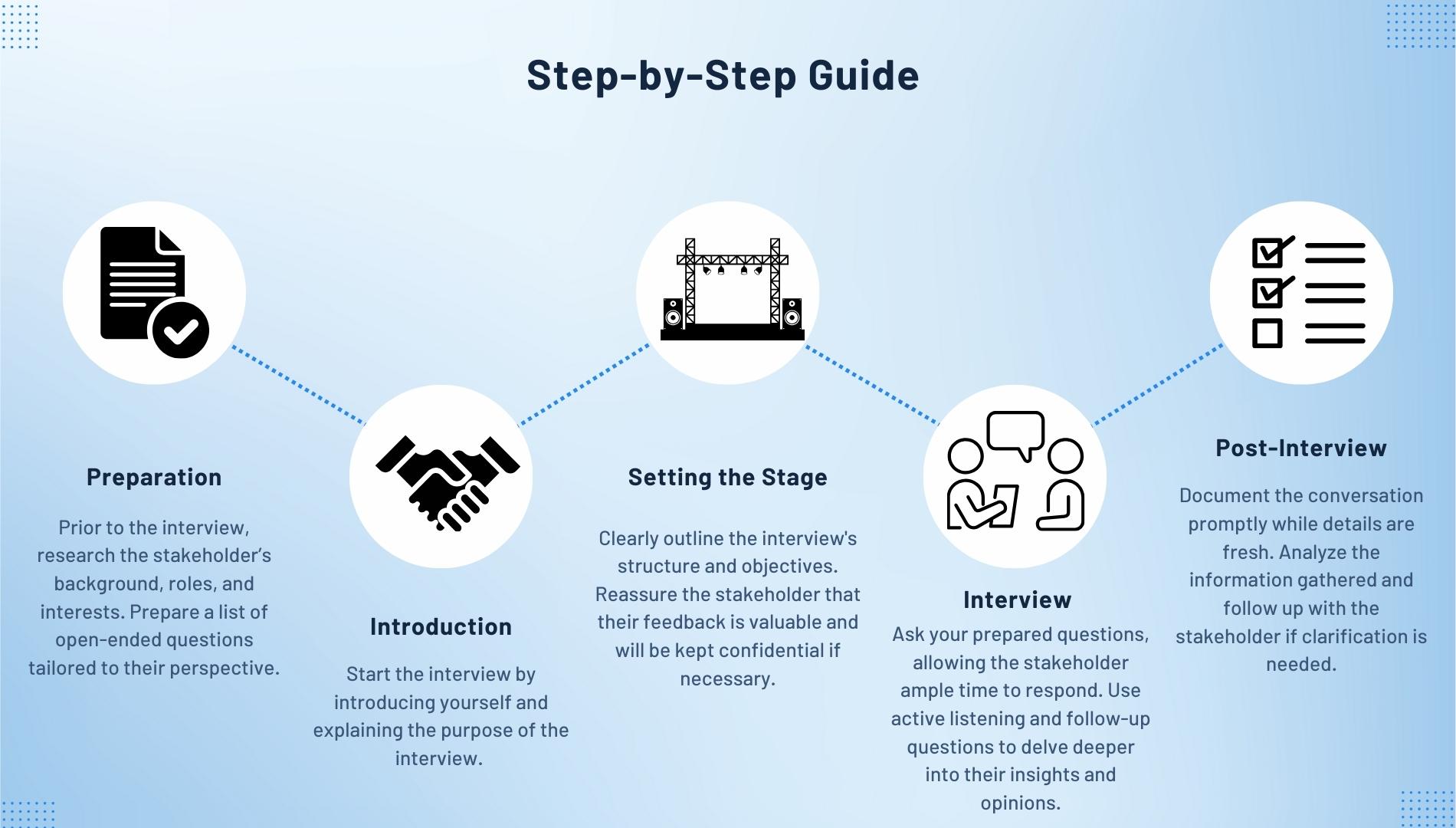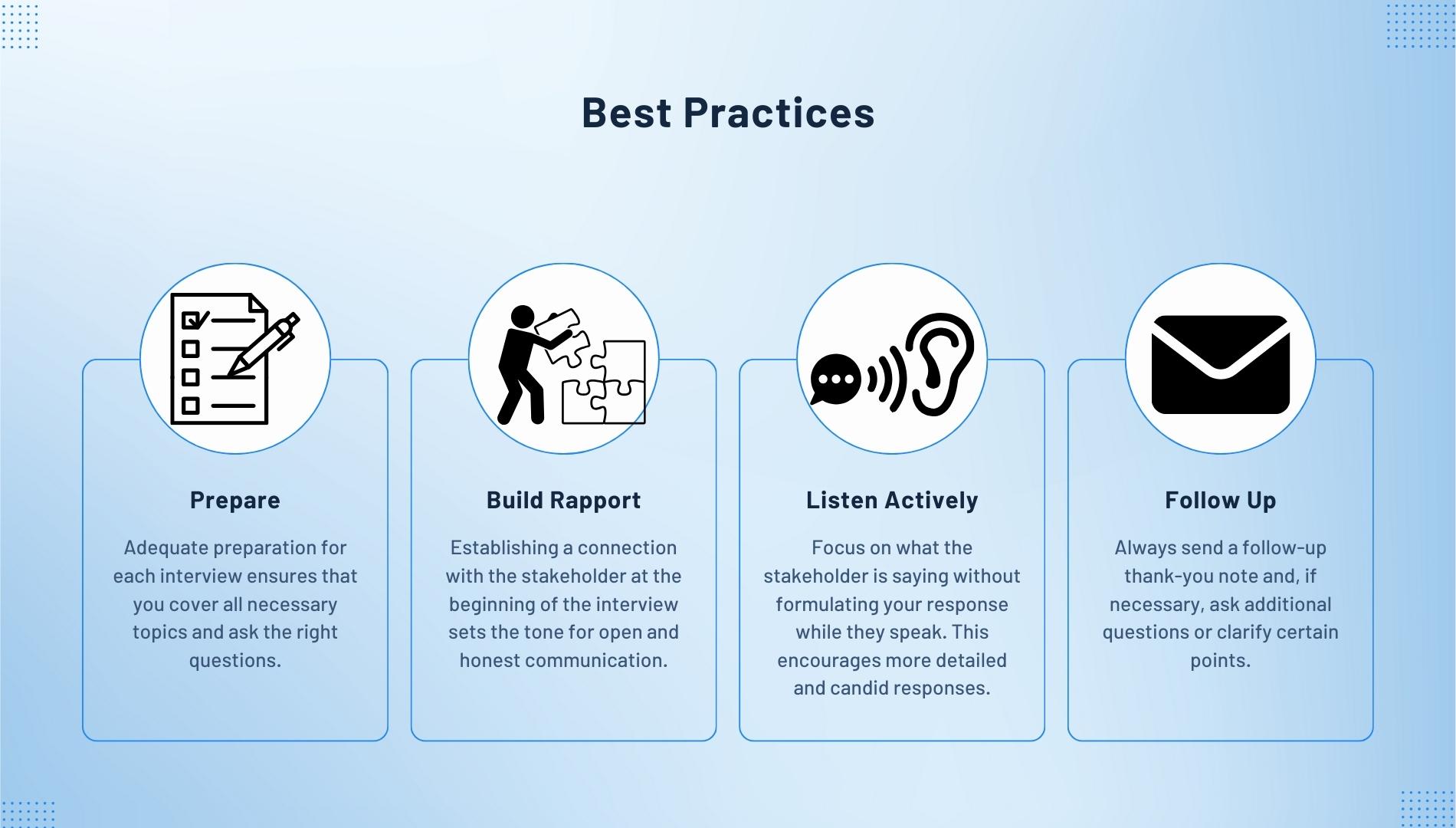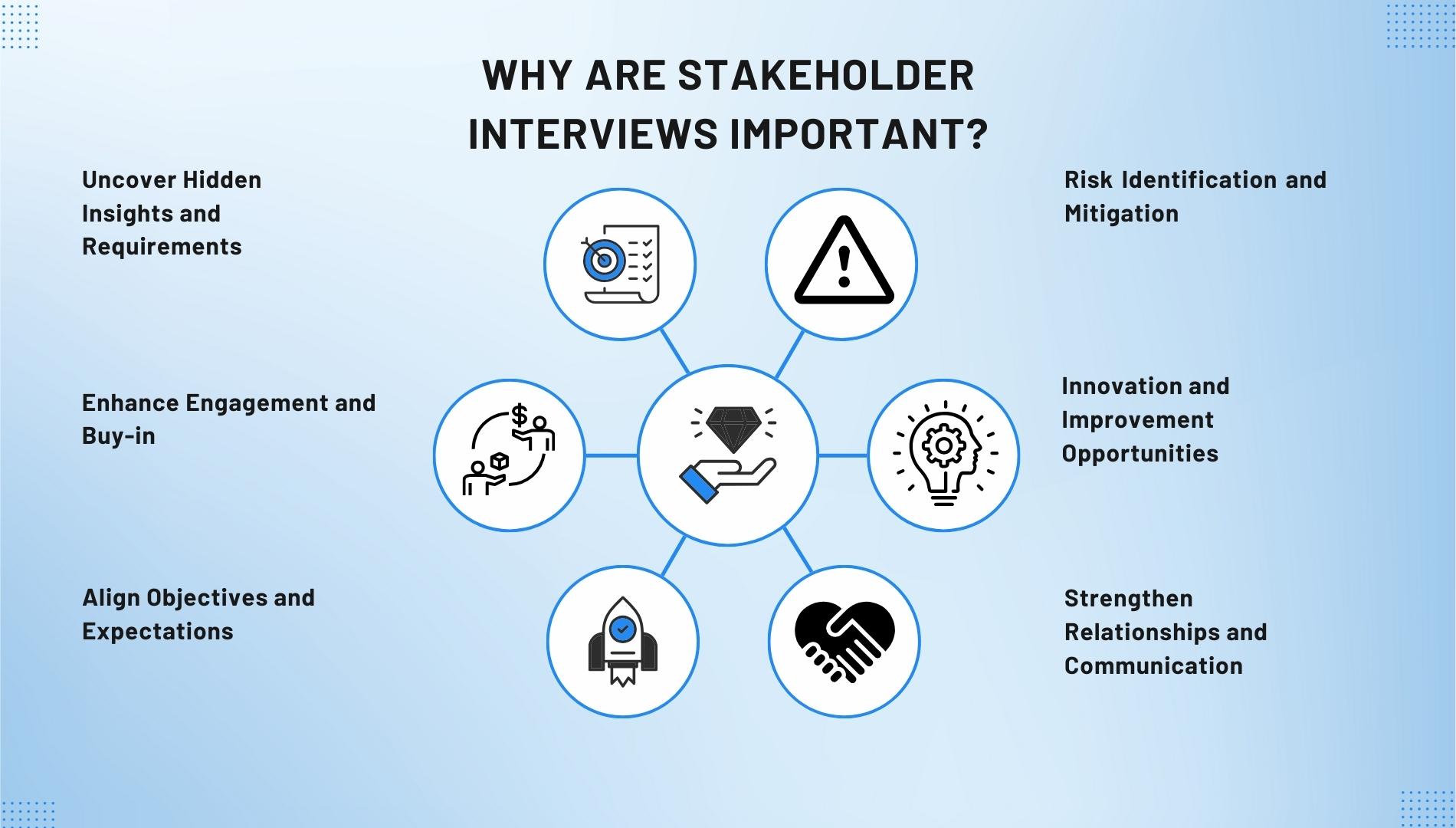Prepare to transform the way you conduct stakeholder interviews, turning every conversation into an opportunity for growth and success.
Preparing for Stakeholder Interviews
The Importance of Stakeholder Interviews
Imagine navigating a ship through foggy waters without a compass; that’s what managing a project can feel like without stakeholder interviews. These interviews are not just formalities; they are crucial navigational tools that provide clarity, direction, and engagement essential for steering any project to success.
Why are stakeholder interviews important? Let’s dive in:
- Uncover Hidden Insights and Requirements: Stakeholder interviews go beyond surface-level information to reveal the underlying expectations, concerns, and needs of those involved or affected by a project. This deep dive helps in uncovering hidden insights that might not be evident in written documents or casual conversations, ensuring that critical requirements are not overlooked.
- Enhance Engagement and Buy-in: When stakeholders are interviewed, they feel heard and valued. This active involvement fosters a sense of ownership and can significantly enhance their commitment to the project's success. Stakeholder buy-in is crucial as it leads to smoother implementation, fewer roadblocks, and enhanced cooperation across teams.
- Align Objectives and Expectations: Projects often involve multiple stakeholders with varying perspectives and objectives. Through interviews, these differing views can be aligned, ensuring that everyone is on the same page. This alignment prevents future conflicts and misunderstandings, saving time and resources.
- Risk Identification and Mitigation: Stakeholders often possess unique insights into potential risks and challenges that may not be visible to the project team. Through interviews, these risks can be identified early, allowing for the development of effective mitigation strategies. This proactive approach reduces the likelihood of project delays and cost overruns.
- Innovation and Improvement Opportunities: Stakeholder interviews are fertile grounds for identifying opportunities for innovation and improvement. Stakeholders can provide valuable feedback on existing processes and offer fresh perspectives that can lead to enhanced project outcomes.
- Strengthen Relationships and Communication: Regular stakeholder interviews establish strong lines of communication and build trust. This improved relationship facilitates more open and honest feedback and collaboration, which is invaluable for project success.
- Validate Data and Assumptions: Projects are often initiated based on certain data and assumptions. Stakeholder interviews provide a reality check, validating or challenging these assumptions with real-world insights. This validation is crucial for ensuring the project remains relevant and feasible.
In summary, stakeholder interviews are a critical element of effective project management. They provide essential insights, foster engagement, align project objectives, identify risks, uncover improvement opportunities, strengthen relationships, and validate project foundations. Ignoring this crucial step can lead to misunderstandings, lack of alignment, missed requirements, and ultimately, project failure. On the other hand, well-conducted stakeholder interviews pave the way for project success.
Unlock the secrets to effective preparation and set the stage for meaningful stakeholder engagement. Click [here] to begin your journey to masterful stakeholder interviews.
Building Relationships with Stakeholders
Building a strong rapport with stakeholders is fundamental to the success of any project. Here are effective techniques and strategies, presented as numbered bullets, for developing robust relationships based on trust, communication, and mutual respect:
- Understand the Stakeholder: Tailor your approach to each stakeholder’s unique background, values, and expectations.
- Open and Clear Communication: Maintain transparency and consistency in all interactions, ensuring stakeholders are regularly updated and informed.
- Active Listening: Engage in active listening, fully concentrating on and understanding stakeholders' viewpoints and feedback.
- Mutual Respect and Empathy: Show genuine respect and empathy for stakeholders' situations and concerns, recognizing them as individuals beyond the project.
- Consistent Engagement: Regularly connect with stakeholders through updates, meetings, and feedback sessions to maintain open lines of communication.
- Providing Value and Support: Identify and deliver on what each stakeholder values, whether it’s solving a problem or supporting their goals.
- Acknowledging Contributions: Recognize and appreciate the contributions of stakeholders, validating their involvement and efforts.
- Transparency and Honesty: Be honest and transparent about challenges and changes, fostering a culture of trust.
- Joint Problem Solving: Involve stakeholders in finding solutions, especially for issues that directly affect them, enhancing their commitment and sense of ownership.
- Personal Touch: Add a personal element to your interactions by remembering and acknowledging the personal details and milestones of stakeholders.
- Continuous Improvement: Actively seek and incorporate feedback from stakeholders on how to improve support and engagement.
By following these strategies, you can effectively answer the question, “How do you build relationships with stakeholders?” and lay down a strong foundation for successful project outcomes and lasting partnerships.
Communicating with Stakeholders
Effective communication with stakeholders is not just about sharing information; it’s about ensuring clarity, establishing regular touchpoints, and choosing the right methods to meet diverse needs. Below, we delve into the best practices in stakeholder communication and provide responses to the crucial question: “How do you communicate with stakeholders?”
- Clarity and Conciseness: When conveying information, be clear and to the point. Avoid jargon and technical language that could lead to misunderstandings. Ensure that your messages are easily understandable to all stakeholders, regardless of their background.
- Regular Updates and Frequency: Establish a regular schedule for updates and stick to it. The frequency should match the pace of the project and the interest level of the stakeholders. For some, weekly updates may suffice, while others may require more frequent check-ins.
- Appropriate Communication Channels: Different stakeholders may prefer different communication methods—emails, meetings, newsletters, or instant messages. Tailor your communication method to suit the preferences of each stakeholder group, ensuring the information reaches them in the most effective way.
- Feedback Mechanisms: Communication should be a two-way street. Provide avenues for stakeholders to give feedback and express their concerns or suggestions. This could be through surveys, feedback forms, or open Q&A sessions during meetings.
- Personalized Communication: Whenever possible, personalize your communication. Address stakeholders by name and reference their specific interests or concerns related to the project. This personal touch can significantly enhance the effectiveness of your communication.
- Transparency and Honesty: Be transparent about project progress, including any setbacks or changes. Honesty builds trust and fosters a positive working relationship with stakeholders.
- Visual Aids and Documentation: Some information is better understood through visuals or written documentation. Use charts, graphs, and project roadmaps when appropriate, and ensure that meeting notes and decisions are well-documented and accessible.
- Cultural Sensitivity and Inclusivity: Be mindful of cultural differences and language barriers that may exist among stakeholders. Ensure that your communication is inclusive and respectful, considering the diverse backgrounds of your audience.
- Active Listening and Responsiveness: Show that you value stakeholders' input by actively listening to their concerns and responding promptly. This demonstrates respect and consideration for their perspectives.
- Conflict Resolution: Be prepared to address conflicts or misunderstandings that may arise. Approach these situations with empathy, aiming to understand the stakeholder’s point of view and working collaboratively towards a resolution.
- Consistency Across the Board: Ensure that the information provided is consistent across all channels and stakeholders. Inconsistencies can lead to confusion and erode trust.
By following these best practices, you’ll be able to answer confidently when asked, “How do you communicate with stakeholders?” Effective communication is the cornerstone of successful stakeholder relationships and, by extension, successful project outcomes.
Handling Difficult Stakeholders
Dealing with challenging stakeholders is an inevitable part of project management. These situations require tact, patience, and a strategic approach to ensure project objectives remain on track while maintaining positive relationships. Below, we outline strategies for managing difficult interactions and aligning with challenging stakeholders.
- Stay Professional and Calm: Always maintain professionalism, regardless of the stakeholder’s behavior. Keep your emotions in check and respond calmly to criticisms or demands. A composed demeanor can help de-escalate tension.
- Empathize and Validate: Try to understand the stakeholder’s perspective and validate their concerns, even if you disagree. Empathy can build a bridge of understanding and open the door to constructive dialogue.
- Set Clear Boundaries and Expectations: Clearly communicate project goals, boundaries, and limitations from the start. This sets realistic expectations and reduces the likelihood of misunderstandings.
- Active Listening and Questioning: Give the stakeholder your full attention and ask clarifying questions. This can help uncover the root cause of their concerns and demonstrate that you value their input.
- Provide Evidence and Reassurance: Use data, facts, and project documentation to support your points and provide reassurance. This can help to alleviate concerns based on misunderstandings or misinformation.
- Seek Common Ground: Identify areas of agreement and build on them. Finding common ground can help shift the focus from conflict to collaboration.
- Involve Them in the Solution: Invite the stakeholder to contribute to finding a solution. Involvement can lead to ownership, reducing resistance and fostering a more cooperative relationship.
- Follow Up and Follow Through: After discussions, follow up with a summary of what was agreed upon and ensure that any promised actions are taken. This builds trust and demonstrates your commitment to resolving the issue.
- Document Interactions: Keep records of your interactions, agreements, and outcomes. Documentation can provide clarity and accountability and can be useful for future reference.
- Seek Support When Needed: If a situation becomes particularly challenging, don’t hesitate to seek support from mentors, peers, or higher management.
Conducting the Stakeholder Interview
Effective stakeholder interviews are pivotal for project success, offering deep insights and fostering stronger relationships. Below is a step-by-step guide to conducting these interviews, along with important considerations such as duration, panel dynamics, and best practices.
 Step-by-Step Guide:
Step-by-Step Guide:
- Preparation: Prior to the interview, research the stakeholder’s background, roles, and interests. Prepare a list of open-ended questions tailored to their perspective.
- Introduction: Start the interview by introducing yourself and explaining the purpose of the interview. Confirm the duration and ensure the stakeholder is comfortable and ready to begin.
- Setting the Stage: Clearly outline the interview's structure and objectives. Reassure the stakeholder that their feedback is valuable and will be kept confidential if necessary.
- Conducting the Interview: Ask your prepared questions, allowing the stakeholder ample time to respond. Use active listening and follow-up questions to delve deeper into their insights and opinions.
- Closing: Summarize the key points discussed and ask if there’s anything they would like to add. Thank them for their time and contributions.
- Post-Interview: Document the conversation promptly while details are fresh. Analyze the information gathered and follow up with the stakeholder if clarification is needed.
Duration:
- A typical stakeholder interview should last between 30 to 60 minutes. This timeframe allows enough space for detailed discussions without causing fatigue. However, the length can vary based on the complexity of the project and the stakeholder’s role.
Panel Interviews:
- In a panel interview, multiple stakeholders are interviewed simultaneously. This can be efficient but may require more preparation.
- Expectations: Panel interviews often have a dynamic interplay; be prepared to manage different personalities and viewpoints.
- Preparation Tips: Provide a clear agenda ahead of time, ensure questions are relevant to all panel members, and plan to allocate time evenly.
- Conducting: Facilitate the discussion to ensure everyone has the opportunity to speak. Be prepared to mediate if disagreements arise.
Best Practices and Tips:
- Clarify Objectives: Ensure your questions align with the interview’s objectives. Clear goals lead to more focused and productive conversations.
- Be Flexible: While it’s important to prepare, be ready to adapt the conversation flow based on the stakeholder's responses.
- Respect Their Time: Start and end the interview on time. Being respectful of the stakeholder’s time contributes to a positive relationship.
- Maintain Neutrality: Keep a neutral stance on the topics discussed to encourage open and honest feedback.
- Non-Verbal Cues: Pay attention to non-verbal signals for a deeper understanding of the stakeholder’s feelings and attitudes.
- Record and Confirm: If possible, record the interview (with permission) for accuracy. Otherwise, take detailed notes and confirm with the stakeholder any critical points they made.
- Confidentiality and Trust: Ensure stakeholders that their input will be treated with confidentiality, increasing their comfort in sharing candid feedback.
- Follow-Up: After the interview, send a thank-you note and a summary of key points, affirming their contribution and the value of their insights.
By following these steps and incorporating the best practices, you can conduct stakeholder interviews that are not only effective but also build trust and engagement, paving the way for successful project outcomes.
Post-Interview Processes
The period following stakeholder interviews is critical for capturing and leveraging the insights gathered to drive your project forward. Proper post-interview actions ensure the valuable information collected is effectively organized, analyzed, and utilized. Here's a guide on what steps to take after your stakeholder interviews to maximize their value:
Post-Interview Actions:
- Document the Interview: As soon as possible after the interview, transcribe or summarize the conversation. This should be done while the details are still fresh in your mind. Include key points, insights, and any non-verbal cues observed.
- Send a Thank-You Note: Show appreciation for the stakeholder’s time and insights with a prompt thank-you message. This not only fosters good relations but also keeps the lines of communication open for future interactions.
- Review and Organize Data: Compile the data from the interview and organize it in a way that aligns with the project’s objectives. This may involve categorizing responses, highlighting recurring themes, or noting any discrepancies.
- Analyze the Insights: Go beyond surface-level observations to analyze the deeper meanings behind the stakeholders’ responses. Look for underlying themes, concerns, and suggestions that could impact the project's direction and outcomes.
- Share and Discuss Findings: Present the findings to your project team or other relevant stakeholders. This should be an interactive session where insights are discussed, potential impacts are considered, and possible actions are debated.
- Follow Up for Clarification or Further Information: If certain points were unclear or if new questions have arisen from the interview data, don’t hesitate to follow up with the stakeholder. This can be done via email, a phone call, or a follow-up meeting.
- Integrate Insights into the Project: Determine how the insights from the interview can influence the project. This might involve adjusting the project plan, redefining objectives, or implementing specific suggestions made by stakeholders.
- Develop an Action Plan: Based on the analysis, create an action plan addressing the identified needs and incorporating stakeholder feedback. Assign responsibilities and set timelines for these actions.
- Update Stakeholders: Keep stakeholders informed about how their input has influenced the project. This transparency demonstrates respect for their contributions and can encourage further engagement and support.
- Reflect and Learn: Finally, reflect on the interview process itself. Consider what went well and what could be improved for future interviews. This continuous improvement approach will enhance the effectiveness of your stakeholder engagement efforts over time.
Analyzing Stakeholder Interviews
After completing stakeholder interviews, the next critical step is to analyze the information gathered. Proper analysis can unearth valuable insights that drive project success. Here’s how to effectively process and utilize the data from your interviews:
- Transcribe and Organize: Begin by transcribing the interviews (if recorded) and organizing the data. This could mean categorizing responses by questions, themes, or stakeholders.
- Identify Key Themes: Read through the transcripts and notes to identify recurring themes or patterns. Look for repeated topics, concerns, or suggestions that emerge across different interviews.
- Evaluate Insights Against Objectives: Compare the insights gained from the interviews against the initial objectives of the project. Determine how these insights align with or differ from your project goals and assumptions.
- Prioritize Information: Not all feedback will be equally relevant or actionable. Prioritize the information based on its impact on the project's success and its urgency.
- Develop Actionable Steps: Translate the key themes and insights into actionable steps for the project. This might involve addressing specific stakeholder concerns, leveraging opportunities identified, or making adjustments to project plans.
- Validate and Contextualize: Cross-check the findings with other data sources for validation. Consider the broader context of the project and how these insights fit within it.
- Report Findings: Summarize the findings in a clear, concise report that highlights key themes, insights, and recommended actions. Include direct quotes from stakeholders to reinforce points and provide authenticity.
- Share and Discuss with Your Team: Share the findings with your project team and other relevant stakeholders. Discuss the implications of the insights and decide on the next steps collaboratively.
Best Practices and Common Pitfalls

- Prepare Thoroughly: Adequate preparation for each interview ensures that you cover all necessary topics and ask the right questions.
- Build Rapport: Establishing a connection with the stakeholder at the beginning of the interview sets the tone for open and honest communication.
- Listen Actively: Focus on what the stakeholder is saying without formulating your response while they speak. This encourages more detailed and candid responses.
- Follow Up: Always send a follow-up thank-you note and, if necessary, ask additional questions or clarify certain points.
- Be Objective: When analyzing responses, maintain objectivity. Avoid letting personal biases influence your interpretation of the data.
Common Pitfalls:
- Underpreparing: Entering an interview without adequate preparation can lead to missed opportunities for valuable insights.
- Leading Questions: Asking leading or biased questions can skew the responses and compromise the integrity of the data.
- Ignoring Non-Verbal Cues: Overlooking non-verbal signals can result in a lack of understanding of the stakeholder’s true feelings or concerns.
- Failure to Follow Up: Not following up after interviews can lead to misunderstandings or missed information and can harm stakeholder relationships.
- Overlooking Data Triangulation: Relying solely on stakeholder interviews without cross-referencing other data sources can lead to biased or incomplete conclusions.
By adhering to these best practices and avoiding common pitfalls, you can maximize the effectiveness of your stakeholder interviews, ensuring that the time and effort invested translate into meaningful insights and positive outcomes for your project.
Conclusion
Stakeholder interviews are an indispensable part of successful project management. They provide critical insights that can shape the direction and outcomes of your initiatives. However, the true value of these interviews is unlocked not just through their execution but through thorough preparation and meticulous analysis afterward. By understanding your stakeholders' perspectives, you can align project goals more closely with their needs and expectations, leading to more successful and sustainable outcomes.
We encourage you to delve deeper into each aspect of the stakeholder interview process through the detailed posts linked throughout this pillar page. From preparing for interviews to analyzing the data collected, each piece offers valuable insights and actionable tips to enhance your stakeholder engagement strategies.
Additional Resources
For expanded learning and deeper dives into specific topics, we recommend the following external resources:



